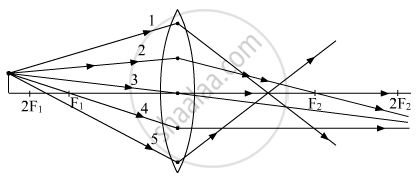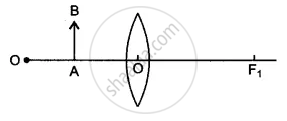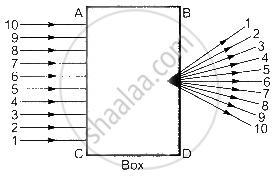Advertisements
Advertisements
प्रश्न
An object 2 cm tall is placed on the axis of a convex lens of focal length 5 cm at a distance of 10 m from the optical centre of the lens. Find the nature, position and size of the image formed. Which case of image formation by convex lenses is illustrated by this example?
उत्तर
Given:
Size of object, h = 2 cm
Focal length, f = 5 cm
Object distance, u =-10 m =-1000 cm
Applying lens formula, we get:
1/v - 1/u = 1/f
1/v = 1/f + 1/u
or, 1/v = 1/5 + 1/(-1000)
or, 1/v=(-200+1)/-1000
or, 1/v=199/1000
or, 1/v=1000/199
or, v=5 cm (approx)
Image distance, v =5 cm behind the lens;
Applying magnification formula, we get:
m = h'/h = v/u
m = h'/2 = (5)/(-1000)
or, h' =-0.01 cm
Thus, the size of the image is 0.01 cm.
So, the image is inverted (h' is negative), highly diminished (h' is smaller than h) and real (v is positive).
Therefore, from the above results we conclude that:
When an object is placed beyond 2f, the image is real, inverted and diminished and is formed between f and 2f.
APPEARS IN
संबंधित प्रश्न
Where should an object be placed in order to use a convex lens as a magnifying glass?
What type of lens would you use as a magnifying glass? How close must the object be to the lens?
How could you find the focal length of a convex lens rapidly but approximately?
A convex lens of focal length 15 cm produces a magnification of +4. The object is placed:
(a) at a distance of 15 cm
(b) between 15 cm and 30 cm
(c) at less than 15 cm
(d) beyond 30 cm
The focal lengths of four convex lenses P, Q, R and S are 20 cm, 15 cm, 5 cm and 10 cm, respectively. The lens having greatest power is :
(a) P
(b) Q
(c) R
(d) S
Out of the five incident rays shown in the figure find the three rays that are obeying the laws of refraction and may be used for locating the position of image formed by a convex lens:
(A) 1, 2 and 3
(B) 2, 3 and 4
(C) 3, 4 and 5
(D) 1, 2 and 4
State the position of object, position of image, nature of image when: Convex lens is used as an erecting lens in terrestrial telescope.
Diagram shows an object AB placed on the principal axis B of a convex lens placed in air. F1 and F2 are the two foci of the lens.

(i) Copy the diagram:
Draw a ray of light starting from B and passing through O. Show the same ray after refraction by the lens. Draw another ray from B which passes through F2 after refraction by the lens. Locate the final image
(ii) Is the image real or virtual?
A beam of light is incident through the holes on side A and emerges out of the holes on the other face of the box as show in the figure. Which of the following could be inside the box?

Which of the following statements is true?
